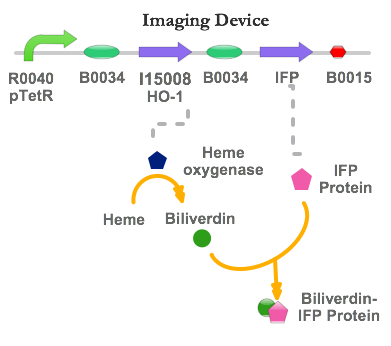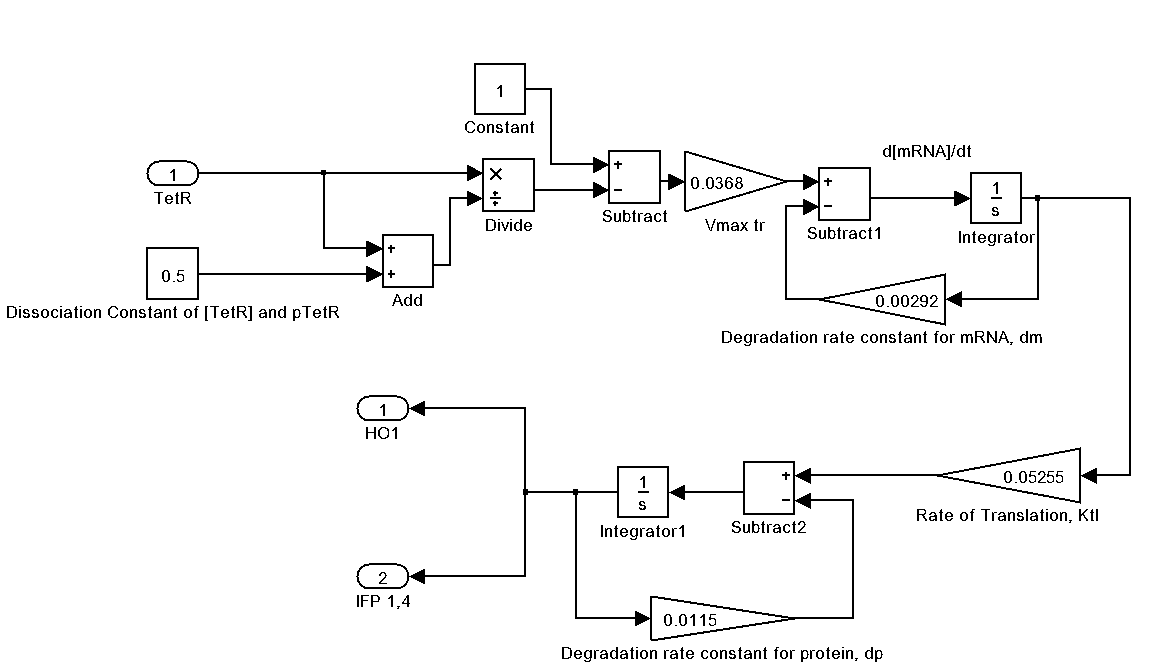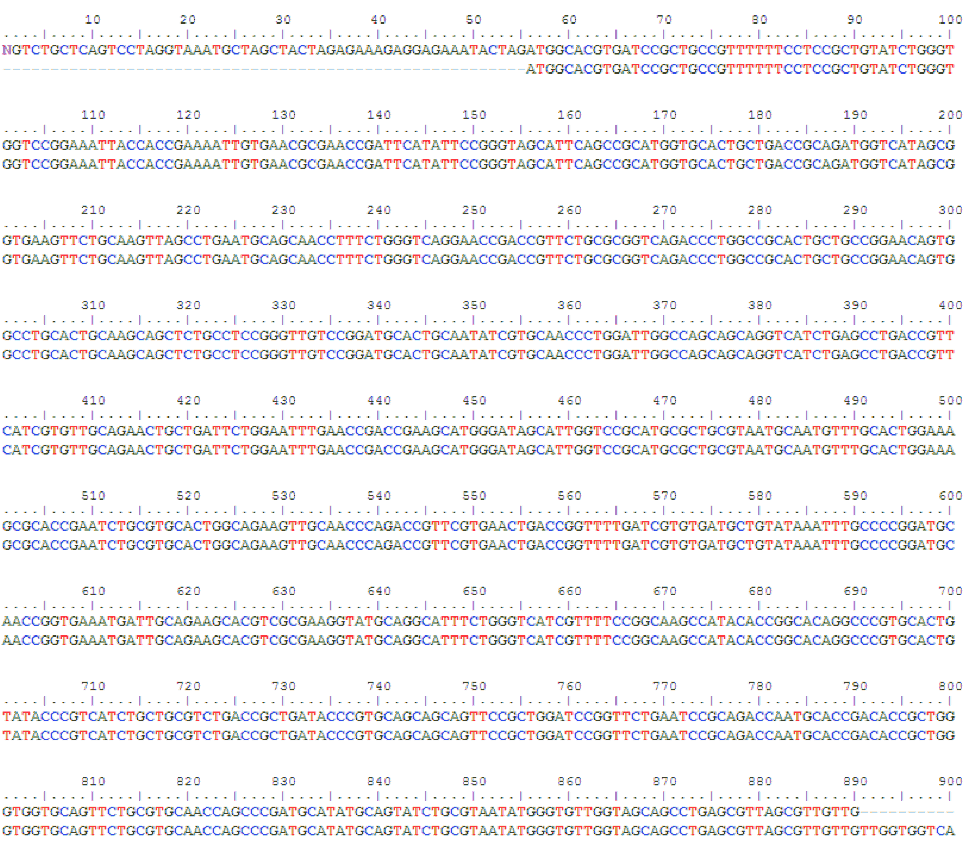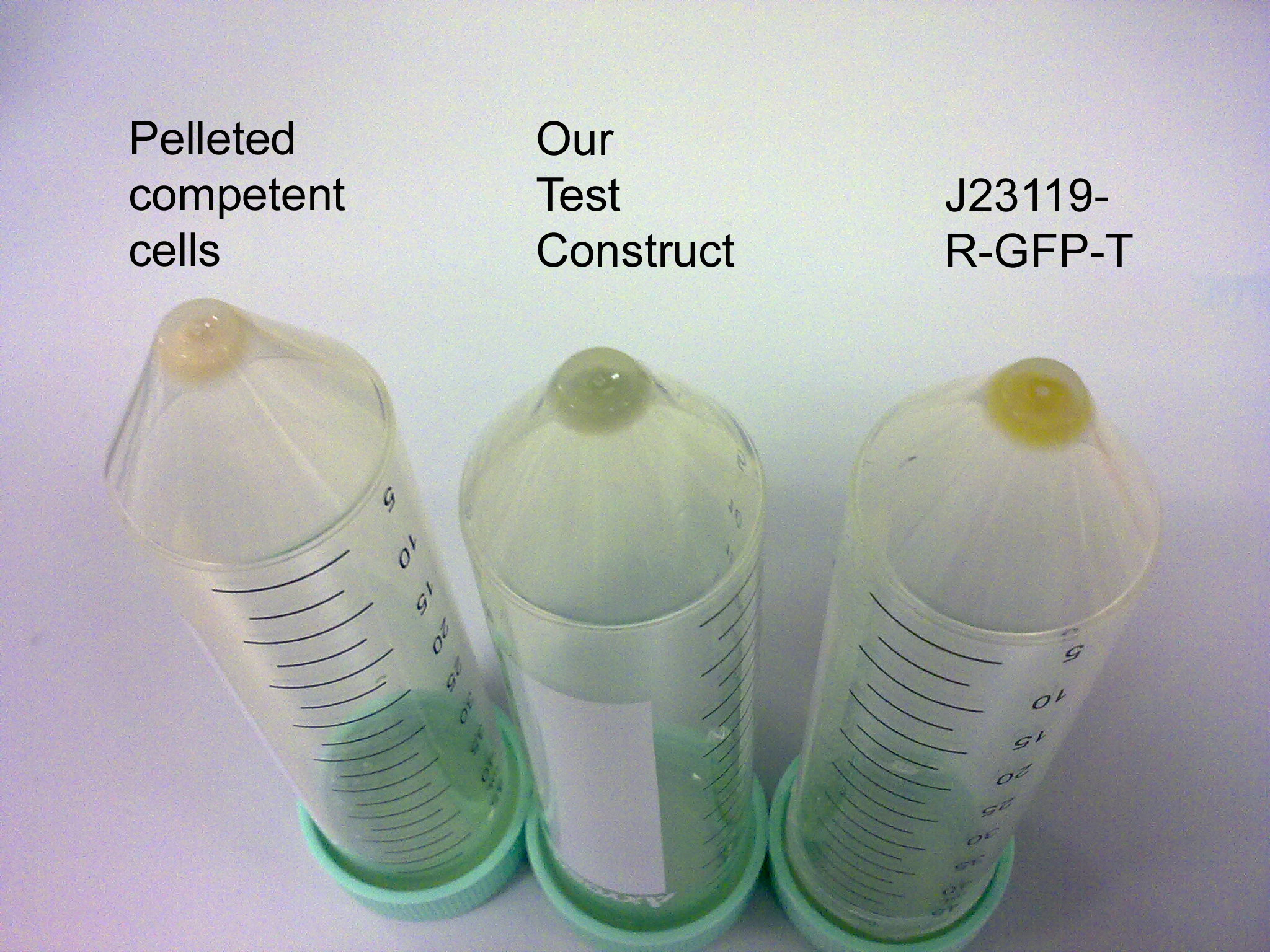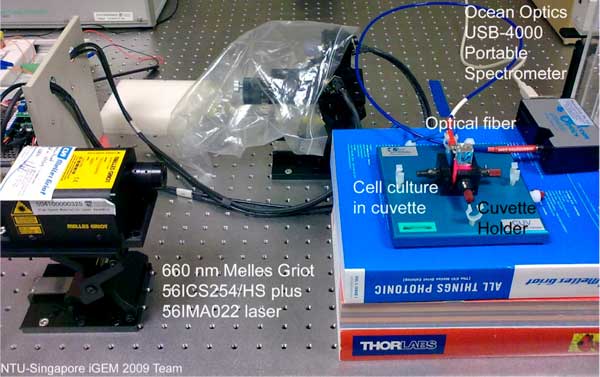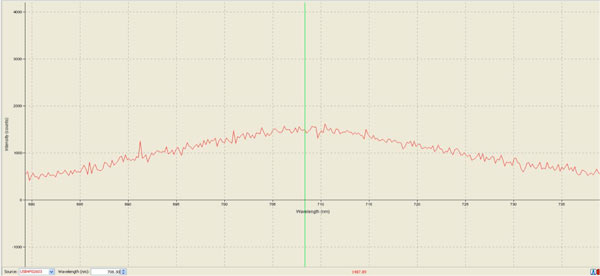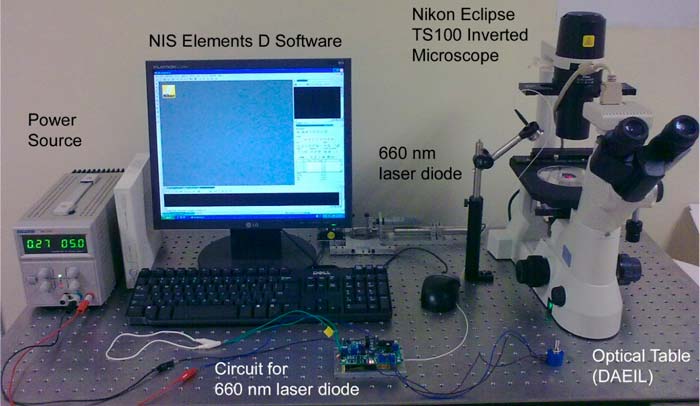Team:NTU-Singapore/Project/Prototype/Image
From 2009.igem.org
Imaging Device
The Imaging device is also one of our featured parts.
As we have elaborated earlier in the Prototype Design section, the device consists of mainly pTet regulated expression of IFP & HO-1, which in turn generate a unique fluorescence signal in the infrared spectrum!
We are extremely pleased to report that we have successfully converted this novel reporter protein into a standard Biobrick! Let us now see how exactly the device works.
Abstract
As part of the imaging capability we want for our system, we have eschewed traditional reporter proteins like GFP or YFP and have identified a novel reporter protein, infrared fluorescent protein (IFP). A recent work by Xiaokun et al. (Tsien Lab, UCSD) has shown successful mammalian expression of infrared fluorescent protein engineered from a bacterial phytochrome. Xiaokun et al. have also expressed the infrared fluorescent protein in E. coli strain TOP10.
IFP is preferred for our system over other fluorescent proteins such as GFP or YFP because it has unique excitation and emission maxima, which fit so well with the wavelength range of typical in vivo optical imaging in deep tissues of animals. At wavelength range between 650 and 900 nm, the absorbance by haemoglobin, water and lipids, as well as light-scattering are minimal.
Therefore, IFP is particularly suitable for our ideal system as we desire to locate the atherosclerotic plaque site non-invasively.
Background
Our pLaqUe Out! system must be capable of highlighting the atherosclerotic plaque site upon detection by the preceding sensing mechanism of nitric oxide sensing promoter (pNO). The first thing that came to our mind was the variety of known fluorescent proteins (FPs) such as GFP, RFP, YFP, CFP. However, since our ultimate environment for our pLaqUe Out! system is in vivo, we envisioned an ideal system that can express a novel reporter protein with properties suitable for in vivo optical imaging. IFP was chosen as a potential candidate.
The gene encoding IFP used in our expression system is essentially the gene for IFP1.4. Xiaokun et al. obtained IFP1.4 by saturation, random mutagenesis, and DNA shuffling of a gene encoding IFP1.0; and it was shown to be about four times brighter than IFP1.0.
Fig 1. - Normalized excitation (blue) and emission (red) spectra for infrared fluorescent protein
Overall, IFP has an excitation and emission maxima of 684 nm and 708 nm, respectively. The excitation and emission maxima for other fluorescent proteins have not exceeded 598 and 655 nm, respectively.
Mechanism
Infrared fluorescent protein is a monomeric protein engineered from a bacterial phytochrome of the species Deinococcus radiodurans.
This bacteriophytochrome incorporates biliverdin IXα (BV) as the chromophore. Biliverdin IXα is in fact a natural product of heme catabolism by the enzyme heme oxygenase-1 (HO-1). BV is essential because in a mouse experiment conducted by Xiaokun et al., BV has been shown to increase the infrared fluorescence to a maximal fivefold 1 hour after BV injection in the mouse with exogenously added BV.
In a phone call made to Dr. Xiaokun Shu, we have also been told that BV helps to stabilize the infrared fluorescent protein. Hence, it is essential that we incorporate HO-1 into our system to generate biliverdin IXα.
Construct Design
As you recall, our ideal system is designed to be in a T-helper cell chassis. However, for infrared fluorescent protein production purposes, we have used E. coli strain K12 as our model system. In order to realize the production system, we have incorporated two parts into the device: the genes encoding infrared fluorescent protein (IFP) and heme oxygenase-1 (HO-1).
The Imaging Device is designed to function only in low [NO] conditions (i.e. in atherosclerotic plaque sites):
After TetR repression stops at plaque site with low [NO], both HO-1 & IFP are produced. The HO-1 catalyzes the conversion of haem to biliverdin, which then binds to IFP to allow generation of infrared signal. Once infrared signalling has begun, we can begin imaging for the plaque site using conventional imaging modality, and establish the location of the plaque site.
Of course, at this stage we also foresee numerous other medical/non-medical uses for the IFP protein!
Characteristic Equations
Transcription of IFP / HO-1
First, we can define the stoichiometric ratio of IFP to HO-1 transcribed.
Next, we establish the deterministic repression-regulated transcription rate of IFP & HO-1.
Where Vmax is max transcription rate & Dm is the degradation rate of mRNA.
Again, bracketed term generates the fraction of pTet not bound with TetR i.e. actively promoting pTet sites.
Translation of IFP / HO-1
Deterministic first order ODE is used again to represent the translation of IFP / HO-1 protein. Same eqn with appropriate term and constants changed.
Where Ktl is the translation rate of mRNA & Dp is the degradation rate of IFP / H0-1 protein.
Infrared signal production
Before the infrared signal can be produced, HO-1 must first convert haem to biliverdin.
And then finally we can determine an equation for rate of infrared signal, (assuming that intensity of infrared signal is directly proportional to the amount of bound-IFP-biliverdin in the system).
 based on the ratio of bound / activated to total [IFP] available:
based on the ratio of bound / activated to total [IFP] available: 
Modelling & Simulation
We make the following assumptions:
- Biological systems of transcription and translation are assumed to be linear and time-invariant.
- Concentration of the haem is considered to be non-limiting.
- There is no time lag between expression & activity.
- Constant Degradation rates for mRNA as well as protein.
- Intensity of infrared signal is directly proportional to [IFP-BV] complex.
The following is our Sensing Device represented as a Simulink system. Please click on it for a larger view.
Device Construction
Researchers at Tsien’s Lab graciously provided us the gene sequence of IFP1.4 optimized for E. coli, and we had the gene encoding IFP1.4 synthesized by GeneArt in accordance with the standard stated by the Registry of Standard Biological Parts.
Part: BBa_I15008 from the Registry of Standard Biological Parts contains the HO-1 gene sequence of cyanobacteria, Synechocystis, and therefore is extracted directly for our needs.
In order to achieve the final construct as described in the device construction, the following Biobricks have been successfully constructed:
- IFP (synthesized by GeneArt) click here for GeneArt sequencing results
- RBS-HO1
- IFP-T
- RBS-IFP
- RBS-HO1-T
- RBS-IFP-T
- RBS-HO1-RBS-IFP-T
- pTet-RBS-HO1-T
- J23119-RBS-HO1-T
- J23119-RBS-IFP-T
- J23119-RBS-HO1-T-J23119-RBS-IFP-T
- J23119-R-IFP-T in KAN vector
Another approach in ensuring our proteins are expressed is by co-transformation of E.coli cell with ampicillin-resistant plasmid of J23119-RBS-HO1-T and kanamycin-resistant plasmid of J23119-RBS-IFP-T.
Our parts listed above have been verified through the correct DNA fragments sizes by running both PCR and double digestion products on agarose gel electrophoresis. Additionally, 1stBASE has sequenced the part J23119-RBS-IFP-T that we have constructed and the results are positive! The summary of the sequencing results is as follows:
J23119 Sequencing
Due to the limit of the Sequencer, the first 10 base pairs of the promoter cannot be verified.
RBS 5 (Part: BBa_B0034)
100% verified!
Terminator (Part: BBa_B0015)
100% sequence identity.
IFP verification
Sequence alignment of our IFP gene (top) with literature sequence (bottom).
We had sent our IFP gene sequence in the final construct for verification and it came back indicating 100% match. This means that our entire construct has perfect identity to that of reported sequence, and sure enough, it WORKS!
Device Characterization
Two approaches are performed in the laboratory to determine the successful expression of infrared fluorescent protein (IFP) or heme oxygenase-1 (HO-1) and thus the functionality of our imaging device. SDS-PAGE is conducted to verify the correct protein size of IFP and HO-1 that we have set out to express.
Imaging experiments with the appropriate optical instruments for the detection of the infrared fluorescence emission of our constructs are also conducted repeatedly. The excitation and emission maxima of IFP are 684 and 708 nm, respectively; thus, our experimental setup must be equipped with the appropriate optical components that are of this wavelength range.
Our positive control for all detection of infrared fluorescence emission in the following optical imaging experiments is cell culture containing plasmids which was generously provided by Tsien’s Lab. (We signed a Materials Transfer Agreement with them!).
We extracted the DNA sample from the paper spot according to the protocol of plasmid resuspension from iGEM paper spots. E. coli strain K12 was transformed with the DNA resuspension. As the gene was being expressed, the cell culture turned green yellowish, indicating the presence of biliverdin in the cell culture.
Cell cultures
(samples of Tsien’s Lab)
The cultures were induced with 20% L-arabinose overnight at 37oC and turned green yellowish due to the formation of biliverdin.
Fluorescence Microscopy
Our first attempt in imaging our cell culture for the construct J23119-RBS-HO1-RBS-IFP-T is through the Axiovert 200 (Zeiss) fluorescence microscope.
Cell culture was inoculated overnight for 16 hours. Prior to the imaging experiment, we re-inoculated the cell culture and allowed the growth for four hours.
The only drawback of the fluorescence microscope was that the filter was of the excitation range of 575-625 nm and emission range of 660-710 nm [far red/cy5]. We further hypothesized that we did not manage to image the infrared fluorescence due to the limitation of appropriate filter for the fluorescence microscope.
As most of the microscopes are equipped with excitation and emission filters of wavelengths that are not in our desired range, we switched our alternatives to self-assembled optical experiment setup. With this in mind, we had collaborated with Prof. Lee Kijoon on the optical imaging.
Optical Experiment Setup
Ocean Optics USB-4000 Portable Spectrometer
A 660 nm Melles Griot 56ICS254/HS plus 56IMA022 laser is used as the light source. The 660 nm laser source fits almost perfectly with the ideal excitation maximum at 684 nm.
We shine the 660 nm laser onto our four-hour re-inoculated cell culture. The Ocean Optics USB-4000 Portable Spectrometer detects any signal emitted by the cell culture with an optical fiber connected to the spectrometer. The optical fiber is pointed and directed towards the cell culture for signal receiving.
The optical fiber is sensitive to any signal, including the excitation laser source. For this reason, we included SEMROCK dichroic mirror placed at 45-degree angle of incidence to isolate the excitation light source from the data acquisition. The emission spectrum for our construct is generated with Ocean Optics SpectraSuite software.
Ocean Optics USB-4000 Portable Spectrometer
Our self-assembled optical experimental setup initiated by Prof. Lee Kijoon for infrared emission detection.
In our attempts to optimize the experimental setup, we conducted repeated experiments with the positive control (sample of Tsien’s Lab) to generate the maximum signal intensity.
Our optical experimental setup proved to be working well when we managed to optimize our readings to a maximum peak of intensity (counts) of 1500 for a 16-hour cell culture incubated at 37°C (fluoresence emission spectrum attached as below) :
Fluorescence emission spectrum of 16-hour Tsien Lab cell culture
Note excitation near the peak excitation wavelength at 660 nm. This fluorescence emission spectrum was obtained with electric dark correction.
Nikon Eclipse TS100 Inverted Microscope
Instead of emission spectrum, cell culture live imaging is performed as well.
The previous optical experiment setup is modified with the inclusion of Nikon Eclipse TS100 Inverted Microscope coupled to DS-Fi1 camera to image the cells. The software NIS Elements D is for image capturing from the microscope.
Another modification we have made to this experimental setup is the replacement of the SEMROCK dichroic mirror with an emission filter, to enable this microscope to function as a fluorescence microscope. The emission filter is the SEMROCK single bandpass filter with the centre wavelength at 710 nm with average transmission of 93% over a range of 40 nm; perfectly fits our expected emission range, with maximum at 708 nm.
We performed the cell culture imaging with the excitation light source of 660 nm laser diode and the SEMROCK single bandpass filter which serves as our emission filter. This modification was done to make Nikon Eclipse TS100 Inverted Microscope functions almost as a fluorescence microscope for our imaging purposes.
Literature / References
Please proceed here to view our full list of references.
 "
"

